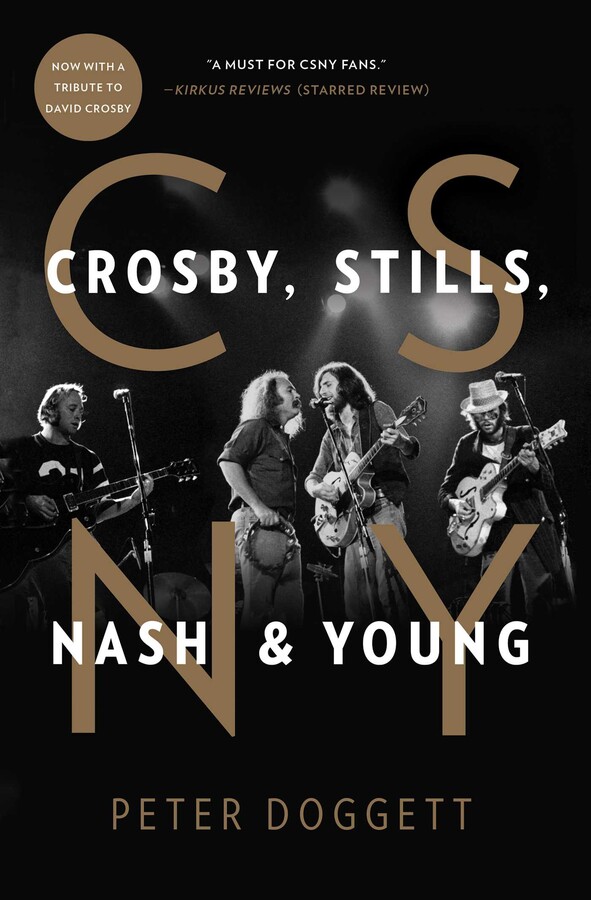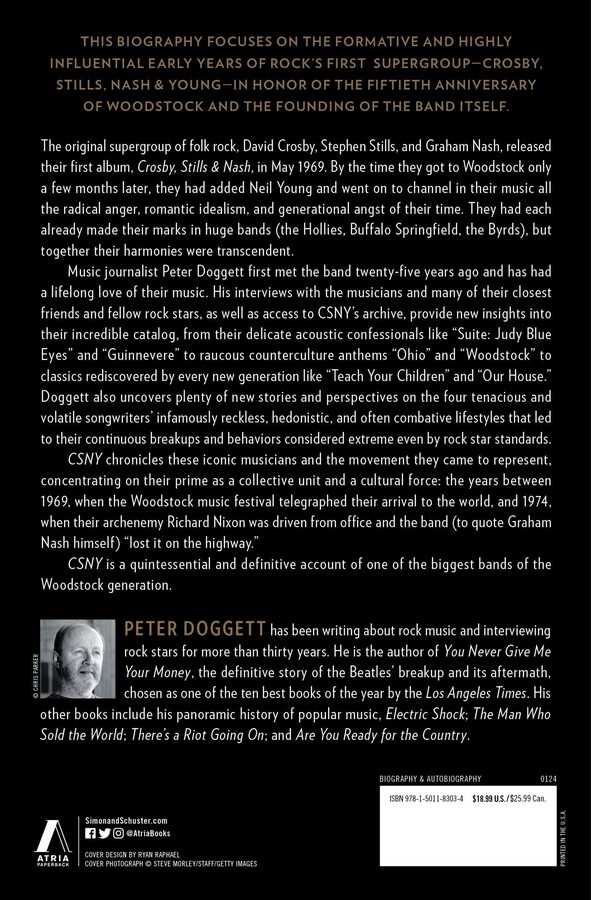Get our latest staff recommendations, classroom reading guides and discover assets for your stores and social media channels. Receive the Children’s Bookseller newsletter to your inbox when you sign up, plus more from Simon & Schuster.If you are an independent bookseller in the U.S. and would like to be added to our independent bookseller newsletter, please email indies@simonandschuster.com
Table of Contents
About The Book
After making their marks in popular bands such as the Hollies and the Byrds, David Crosby, Stephen Stills, and Graham Nash released their first album in May 1969. By the time they arrived at Woodstock a few months later, Neil Young had joined their ranks and together, their transcendent harmonies and evocative lyrics channeled all the romantic idealism and radical angst of their time.
Now, music journalist Peter Doggett chronicles these legendary musicians and the movement they came to represent at the height of their popularity and influence: 1969 to 1974. Based on interviews with the band and colleagues, along with exclusive access to CSNY’s archive, Doggett provides new insights into their incredible catalog, from their delicate acoustic confessionals like “Suite: Judy Blue Eyes” to their timeless classics such as “Our House.” Doggett also uncovers plenty of new stories and perspectives on the four tenacious and volatile songwriters’ infamously reckless, hedonistic, and often combative lifestyles that led to their continuous breakups and behaviors—extreme even by rock star standards.
“A must for CSNY fans and anyone who remembers the era when it ruled the pop charts” (Kirkus Reviews, starred review), CSNY is a quintessential and definitive account of one of the biggest bands of the Woodstock generation.
Excerpt
Asked, in a 1985 interview, to imagine an alternative lifetime in which he could have joined any musical outfit in the world, Bob Dylan singled out some of the catalysts of American roots music—pivotal bands in the development of jazz, country, and R&B. Then he astounded the journalist by offering a more modern name, one whose critical standing could hardly have been lower in the year of Live Aid: Crosby, Stills & Nash. A decade later, Dylan recorded a rambling folk ballad entitled “Highlands,” in which—for the first time in his career—he namechecked one of his contemporaries from the world of rock and pop: Neil Young. It was as close as the notoriously reticent Nobel laureate could have come to acknowledging his admiration for a quartet that had been acclaimed as America’s first rock supergroup, and that remains, fifty years later, the most powerful symbol of the so-called Woodstock generation.
David Crosby, Stephen Stills, Graham Nash, and Neil Young—the singer-songwriter collective universally known as CSNY—came together by accident rather than design. Scarred by their unhappy experiences with the bands from which they escaped in 1967 and 1968, they vowed that they would never become a group. Instead they set out to prove that it was possible for four irrepressibly creative, willfully egotistical individuals to combine their talents without sacrificing their personal identities. But they hadn’t allowed for the impact of artistic and commercial success, which transformed this loose, temporary aggregation of musicians into an institution. Crosby, Stills, Nash & Young have spent approximately two of the past fifty years as a functioning band, and the other forty-eight years fending off questions about why they are no longer together. Almost despite themselves, they created a sound and a myth so powerful that it would hang around their necks as a curse, and remain an enduring source of fascination for the rest of the world.
CSNY was never intended to be a quartet, even a transient one. In 1968, three refugees from successful but confining pop bands stumbled into each other’s company and discovered that when they sang together, they made a sound that was unlike anything else. For several weeks that year, ex-Byrd David Crosby, Buffalo Springfield leader Stephen Stills, and Hollies vocalist Graham Nash showed off their party trick for their peers in Laurel Canyon, and watched them gape in astonishment at the harmony blend they had found. All three men had songs to match, intensely personal expressions of romantic, psychological, and political turmoil that chimed with the spirit of their generation. Soon Crosby, Stills & Nash (alias CSN) was an act with a recording contract, and a manifesto that stressed both their brotherhood and their individual independence. They cut a debut album that caught the mood of the times and stoked rampant demand for a concert tour that could transport the Canyon’s secret to the rest of America.
Only then did Stills make the fateful decision to invite his sparring partner from Buffalo Springfield, Neil Young, to flesh out the trio’s sound onstage. His recruitment brought a fourth maverick voice and mercurial songwriter into the mix. It transformed CSN into CSNY, and irrevocably altered the original trio’s delicate balance of power and creativity. The quartet came to national prominence with their performance at the Woodstock festival in August 1969, after which their music and their image became indissolubly linked with the fate of the baby-boomer era.
The road from Laurel Canyon to Woodstock had spanned precisely one year; and over the next twelve months, everything CSNY had built fell to pieces around them. But the resonance of their image, and the power of their music, remained undimmed, even as it haunted the four men’s attempts to thrive outside the band. Eventually, and inevitably, the four men came back together, for an epic, groundbreaking 1974 tour that catapulted rock culture into a new era of greed and excess—and also ensured that Crosby, Stills, Nash & Young could never function again as a brotherhood of equals.
How could a union so brief and so troubled have left such a profound impression on American culture? If the initial pull of CSN was their vocal harmonies, what made CSNY so vital, and their legacy so deep, was the impact of their songs—and the personalities that powered them. Indeed, the men and their music became impossible to distinguish: their songwriting expressed exactly who they were, and what was happening around them, and it allowed their listeners to locate their own place in a world beset by conflict and oppression.
Each of the quartet had left a distinct mark on the mid-1960s pop scene, from Crosby’s chart-topping singles with the Byrds and Nash’s worldwide success with the Hollies to Stills’s and Young’s tempestuous, inspired work with Buffalo Springfield. With Springfield’s 1967 hit “For What It’s Worth,” Stills had demonstrated that a song could transcend its origins and become an all-purpose rallying cry in an age searching for direction and stability. What marked out CSNY from their peers was that all four members of the band simultaneously discovered the ability to speak for, and to, their times. They did this in markedly different ways, from Crosby’s provocative political rants to Nash’s romantic lyricism, Stills’s restless self-questioning to Young’s ambiguous poetics. But collectively their four discrete voices combined to make up a force unlike any in rock history—a cabal of gifted, driven, arrogant, and fearless lyricists and composers, with the stage presence and raw talent to translate the chaos of a turbulent era into timeless anthems.
It is those tunes—“Carry On” and “Long Time Gone,” “Helpless” and “Teach Your Children,” “Ohio” and, of course, Joni Mitchell’s “Woodstock”—that make up the quartet’s most beloved legacy. CSN and CSNY released just twenty-two songs together during their brief flowering in 1969 and 1970, and most of them have become rock standards. They’ve formed the heart of every concert that the band (in either formation) has performed since then, arousing a collective sigh of joy from audiences, no matter how stale they have become for their composers. But while crowds called out for a reprise of their greatest hits, all four musicians were desperate to forge new ground, documenting the changes in their psyches, their personal relationships, and the society around them. So the story of CSNY is not only a chronicle of artistic triumph and popular acclaim; it’s the tale of how four individuals battled to maintain their separate artistic identities when much of their audience simply wanted them to repeat the past.
I’m a fan, and have been unashamed about it, even during those decades when proclaiming your love for CSNY was tantamount to joining a leper colony. For reasons I can’t quite explain, but I can always feel, the music made by those four men still touches me more deeply than any other. I can see and describe its faults, but as in any enduring love affair, they are ultimately irrelevant. “Music gets you high,” Graham Nash once wrote, and their music always works for me, even without the chemical and herbal aids that used to be synonymous with the band during their most self-indulgent eras.
I’ve been fortunate to have interviewed, befriended, and worked on projects with many of the members of the band and their circle. What emerged was the story of how four preternaturally talented, and utterly distinct, individuals found their way into each other’s company; created music that can still make it feel wonderful to be alive; and then, almost immediately, let the magic slip away. One decade was the key to their collective lives: the period between 1964 and 1974, which carried them from musical apprenticeships to what was then the most lucrative tour in rock history.
Something remarkable happened to bring them together; and something fundamental vanished when their 1974 tour and its aftermath drove them apart. Any sense that CSNY was an active, functioning, real band ended that year. Since then, only memories and fragments of the dream have survived: delicious fantasies that have sometimes managed to mask the profound dysfunction of their collective relationship. But there is something so thrilling, so life-affirming, so magical in the sound that those musicians can make and have made together that it is possible to forgive all those decades of missed opportunities; all the “time we have wasted on the way,” as Graham Nash once put it.
Product Details
- Publisher: Atria Books (January 16, 2024)
- Length: 384 pages
- ISBN13: 9781501183034
Browse Related Books
Raves and Reviews
"An enthusiastic history of one of rock music’s most significant supergroups. . . . The narrative is eminently readable. . . . A must for CSNY fans and anyone who remembers the era when it ruled the pop charts."
—Starred Kirkus Review
"Plenty of nuggets for the diehard fan...a more than welcome addition to the band’s bookshelf."
– Houston Press
"A meticulous chronicle . . . but also a deft portrait of a golden age tarnishing even as the band sang."
– Sunday Times (London)
"Engaging . . . Doggett uses the saga of Crosby, Stills, Nash & Young as a metaphor for the Woodstock generation and their doomed mission to return to the garden."
– The Times (London)
"This honest, occasionally laudatory history will delight its baby boomer audience."
– Publishers Weekly
Resources and Downloads
High Resolution Images
- Book Cover Image (jpg): CSNY Trade Paperback 9781501183034
- Author Photo (jpg): Peter Doggett Photo by Chris Parker(0.1 MB)
Any use of an author photo must include its respective photo credit






